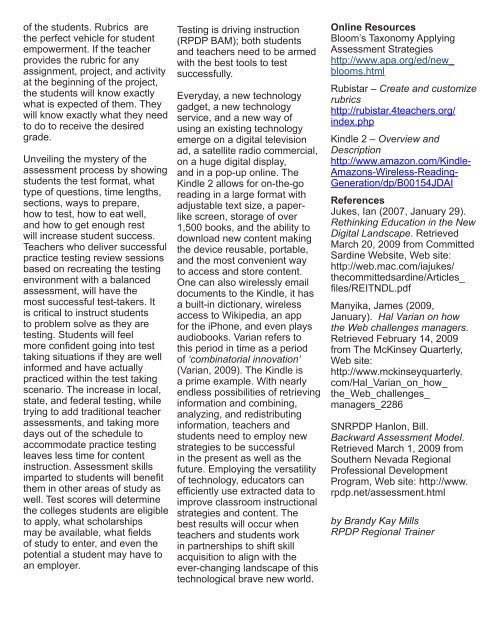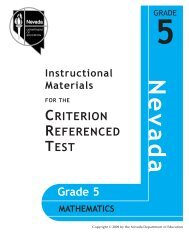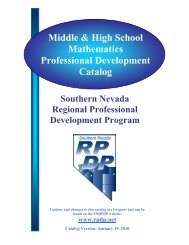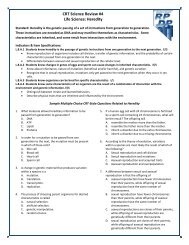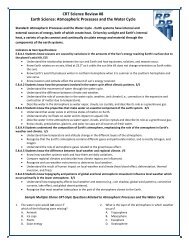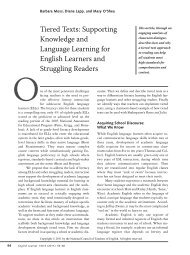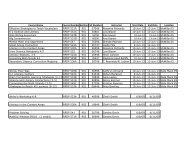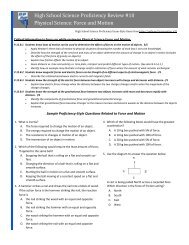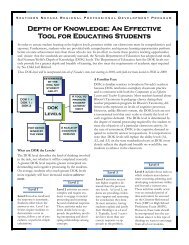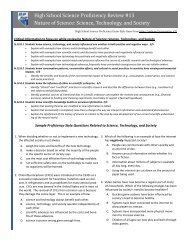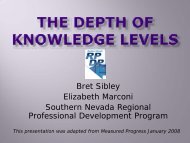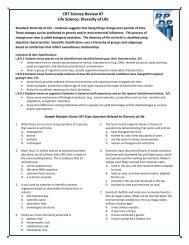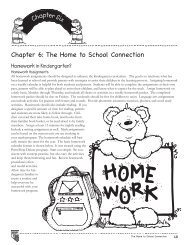Download - RPDP
Download - RPDP
Download - RPDP
Create successful ePaper yourself
Turn your PDF publications into a flip-book with our unique Google optimized e-Paper software.
of the students. Rubrics are<br />
the perfect vehicle for student<br />
empowerment. If the teacher<br />
provides the rubric for any<br />
assignment, project, and activity<br />
at the beginning of the project,<br />
the students will know exactly<br />
what is expected of them. They<br />
will know exactly what they need<br />
to do to receive the desired<br />
grade.<br />
Unveiling the mystery of the<br />
assessment process by showing<br />
students the test format, what<br />
type of questions, time lengths,<br />
sections, ways to prepare,<br />
how to test, how to eat well,<br />
and how to get enough rest<br />
will increase student success.<br />
Teachers who deliver successful<br />
practice testing review sessions<br />
based on recreating the testing<br />
environment with a balanced<br />
assessment, will have the<br />
most successful test-takers. It<br />
is critical to instruct students<br />
to problem solve as they are<br />
testing. Students will feel<br />
more confident going into test<br />
taking situations if they are well<br />
informed and have actually<br />
practiced within the test taking<br />
scenario. The increase in local,<br />
state, and federal testing, while<br />
trying to add traditional teacher<br />
assessments, and taking more<br />
days out of the schedule to<br />
accommodate practice testing<br />
leaves less time for content<br />
instruction. Assessment skills<br />
imparted to students will benefit<br />
them in other areas of study as<br />
well. Test scores will determine<br />
the colleges students are eligible<br />
to apply, what scholarships<br />
may be available, what fields<br />
of study to enter, and even the<br />
potential a student may have to<br />
an employer.<br />
Testing is driving instruction<br />
(<strong>RPDP</strong> BAM); both students<br />
and teachers need to be armed<br />
with the best tools to test<br />
successfully.<br />
Everyday, a new technology<br />
gadget, a new technology<br />
service, and a new way of<br />
using an existing technology<br />
emerge on a digital television<br />
ad, a satellite radio commercial,<br />
on a huge digital display,<br />
and in a pop-up online. The<br />
Kindle 2 allows for on-the-go<br />
reading in a large format with<br />
adjustable text size, a paperlike<br />
screen, storage of over<br />
1,500 books, and the ability to<br />
download new content making<br />
the device reusable, portable,<br />
and the most convenient way<br />
to access and store content.<br />
One can also wirelessly email<br />
documents to the Kindle, it has<br />
a built-in dictionary, wireless<br />
access to Wikipedia, an app<br />
for the iPhone, and even plays<br />
audiobooks. Varian refers to<br />
this period in time as a period<br />
of ‘combinatorial innovation’<br />
(Varian, 2009). The Kindle is<br />
a prime example. With nearly<br />
endless possibilities of retrieving<br />
information and combining,<br />
analyzing, and redistributing<br />
information, teachers and<br />
students need to employ new<br />
strategies to be successful<br />
in the present as well as the<br />
future. Employing the versatility<br />
of technology, educators can<br />
efficiently use extracted data to<br />
improve classroom instructional<br />
strategies and content. The<br />
best results will occur when<br />
teachers and students work<br />
in partnerships to shift skill<br />
acquisition to align with the<br />
ever-changing landscape of this<br />
technological brave new world.<br />
Online Resources<br />
Bloom’s Taxonomy Applying<br />
Assessment Strategies<br />
http://www.apa.org/ed/new_<br />
blooms.html<br />
Rubistar – Create and customize<br />
rubrics<br />
http://rubistar.4teachers.org/<br />
index.php<br />
Kindle 2 – Overview and<br />
Description<br />
http://www.amazon.com/Kindle-<br />
Amazons-Wireless-Reading-<br />
Generation/dp/B00154JDAI<br />
References<br />
Jukes, Ian (2007, January 29).<br />
Rethinking Education in the New<br />
Digital Landscape. Retrieved<br />
March 20, 2009 from Committed<br />
Sardine Website, Web site:<br />
http://web.mac.com/iajukes/<br />
thecommittedsardine/Articles_<br />
files/REITNDL.pdf<br />
Manyika, James (2009,<br />
January). Hal Varian on how<br />
the Web challenges managers.<br />
Retrieved February 14, 2009<br />
from The McKinsey Quarterly,<br />
Web site:<br />
http://www.mckinseyquarterly.<br />
com/Hal_Varian_on_how_<br />
the_Web_challenges_<br />
managers_2286<br />
SN<strong>RPDP</strong> Hanlon, Bill.<br />
Backward Assessment Model.<br />
Retrieved March 1, 2009 from<br />
Southern Nevada Regional<br />
Professional Development<br />
Program, Web site: http://www.<br />
rpdp.net/assessment.html<br />
by Brandy Kay Mills<br />
<strong>RPDP</strong> Regional Trainer


